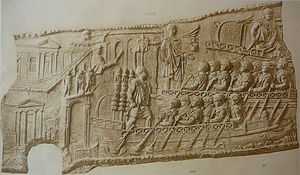Classis Flavia Moesica

 | ||||
| Part of a series on the | ||||
| Military of ancient Rome | ||||
|---|---|---|---|---|
| Structural history | ||||
|
||||
| Campaign history | ||||
| Technological history | ||||
|
||||
| Political history | ||||
|
|
||||
| Strategy and tactics | ||||
|
||||
| Military of ancient Rome portal | ||||
The Classis Flavia Moesica ("Flavian Fleet of Moesia") was the Roman Empire's fleet on the lower Danube river. near the Black Sea.
History
The Classis Moesica was established sometime between 20 BC and 10 AD. It was based in Noviodunum and controlled the Lower Danube from the Iron Gates to the northwestern Black Sea as far as the Crimea.[1] The honorific Flavia, awarded to it and to the Classis Pannonica, may indicate its reorganization by Vespasian around 75 AD.[2] After Domitian (in 85 AD) it was headquartered in Sexaginta Prista. After Trajan's conquest of Dacia, during which the Classis Moesica provided logistical support, its base was moved to Noviodunum. The fleet also included several secondary ports, like Novae, Oescus and Tomi (actual Constanta). From 41 AD detachments were stationed in Crimea and Tyras.
In a series of Roman provinces a river forms the border of the Empire. In Europe this is the case for the provinces on the Rhine and the Danube. We know of three provincial fleets here, the classis Germanica, the classis Pannonica and the classis Moesica. Although one could conclude from their names that their areas of operations stretched over both provinces bearing their corresponding name, this was not the case. Thus, so-called military diplomas clearly show for the classis Pannonica and the classis Moesica that they belonged to the army of Pannonia Inferior and Moesia Inferior respectively[3]
The Classis Moesica lasted until the beginning of the fifth century, being later assimilated within the Byzantine navy.[4]
Ships and troops
The attested ships used by the Moesian fleet were mainly the ubiquitus liburnae used by most Roman provincial fleets, of which two names survive: "Armata" & "Sagita".
In Scythia Minor, during late Antiquity there were marines (muscularii)[5] of legio II Herculia at "Inplateypegiis" and sailors (nauclarii) at Flaviana.[6]
Notes
- ↑ Webster & Elton (1998), pp. 162-165
- ↑ Webster & Elton (1998), p. 163
- ↑ Roman Fleets
- ↑ Map showing the "Classis Moesica" area
- ↑ musculus (meaning "small mouse") was a kind of small ship
- ↑ Notitia Dignitatum, Notitia Dignitatum, Pars Orient., XXXIX.
Bibliography
- Starr, Chester G. (1960 [1941]) The Roman Imperial Navy: 31 B.C.-A.D. 324 (2nd Edition). Cambridge: Heffer.
- Webster, Graham; Elton, Hugh. (1998) The Roman Imperial Army of the First and Second Centuries A.D. Norman: University of Oklahoma Press. ISBN 0-8061-3000-8